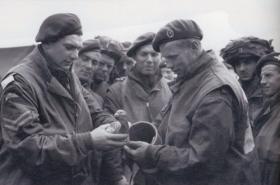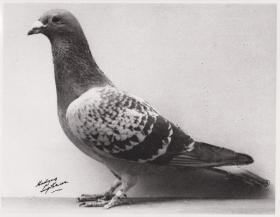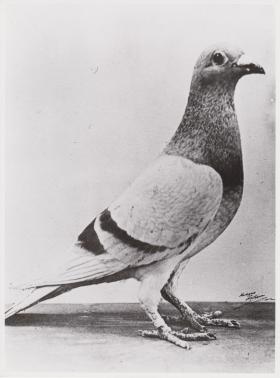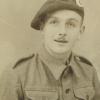During the Second World War, pigeons were used by the Armed Services to carry messages between troops fighting in Europe, and between Europe and Britain. Thousands of pigeons were given to the armed forces by members of the public for use in the war effort, and were used by the army, RAF and civil defence forces.
Use of pigeons was not limited to British Armed Forces: American and German troops also used them in Europe and the Far East.
Pigeons were carried in by crews in aircraft and landed with paratroopers. British paratroopers carried the pigeons in small cardboard containers, worn strapped to the front of a soldier’s equipment, and under the smock. American troops used slings to carry pigeons, looped over one arm. Messages could be placed in a tube on the pigeon’s foot or in a larger tube on the back of the animal.
Several pigeons were awarded medals, including the Dickin Medal, otherwise known as the Animal’s VC. Two of these were awarded to pigeons attached to British Airborne Forces:
Duke of Normandy
Duke of Normandy, pigeon number NURP 41 SBC 219, served with the 6th Airborne Divisional Signals.
On 1 June 1944, Duke of Normandy was placed in a small cardboard container which was strapped to Lt Loring as he jumped into Normandy on 6 June 1944.
After the capture of Merville Battery, Duke of Normandy was released at 6.00 hours carrying a message, and flew through aerial bombardment and bad weather to reach the UK 26 hours and 50 minutes after being released.
On 8 January 1947 he was awarded the Dickin Medal, the citation reading as follows:
“For being the first bird to arrive with a message from Paratroops of 21st Army Group behind enemy lines on D Day 6 June, 1944, while serving with APS.”
William of Orange
William of Orange, pigeon number NS 15125, was bred by Sir William Proctor Smith of Bexton House, Bexton, near Knutsford. He was a mealy cock and was trained by the Army Pigeon Service. During training he once covered 68 miles in 58 minutes.
On service with the 2nd Parachute Battalion, Signals Section at Arnhem he was released at 10.30 hours on 19 September, 1944 and returned to his loft in England at 14.55 hours the same day, having flown 260 miles, of which 135 miles were over open sea.
The Allied Forces Mascot Club Awards Committee in May 1945 awarded him the Dickin Medal. The entry in the Roll of Honour is maintained in the Reception Room of the Headquarters of the People’s Dispensary for Sick Animals.
The citation reads: “For delivering a message from the Arnhem Airborne Operation in record time for any single pigeon, while serving with the APS in September 1944.”
At the end of the Second World War, well-known animals were sold in aid of Service charities and Sir William bought William of Orange out of the service for £135.
Nearly ten years later he was able to record that William of Orange was now too old to race or breed, but was the grandfather of many birds who were doing magnificently, and he would have an honoured perch in Sir William’s loft as long as he should live.
Lady Smith, widow of the owner, presented the Dickin Medal to the Royal Signals Museum in 1965.
William of Orange was the twenty-first animal to receive the Dickin Medal.
By Rebecca Blackburn with information supplied by Bob Hilton and the PDSA.









Latest Comments
There are currently no comments for this content.
Add Comment
In order to add comments you must be registered with ParaData.
If you are currently a ParaData member please login.
If you are not currently a ParaData member but wish to get involved please register.